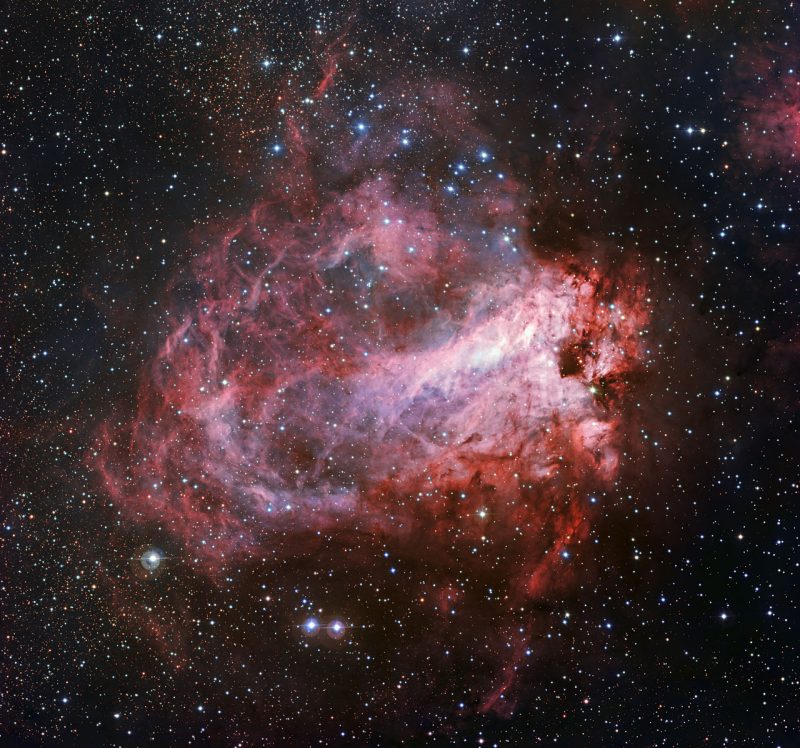

The Wide Field Imager on the 2.2-meter telescope at ESO’s La Silla Observatory in Chile captured this image of the rose-colored star-forming region Messier 17. Image via Messier-objects.com.
Barely visible to the unaided eye on a dark, moonless night, Messier 17 – aka the Omega Nebula – is best seen though binoculars or low power on a telescope. It’s very near another prominent nebula known as Messier 16, the Eagle Nebula, home nebula of the famous Pillars of Creation photograph. These two closely-knit patches of haze readily fit within the same binocular field of view.

Flickr user Mike Durkin captured this image of M16 and M17.

How to star-hop from the Teapot to Messier 16 and Messier 17
How to see M17. If you want to see deep-sky objects like this one, learn to recognize the constellation Sagittarius the Archer. It’s located in the direction to the center of our Milky Way galaxy; many beautiful star clusters and nebulae can be found in this part of the sky. Luckily, this constellation contains an easy-to-find star pattern, or asterism, in the shape of a teapot. From the legendary Teapot asterism in Sagittarius, it’s fairly easy to star-hop to the Omega Nebula and its companion nebula, M16.
From the Teapot, draw an imaginary line from the star Kaus Austrinus and pass just east (left) of the star Kaus Media to locate M16 and M17. These two nebulae are close together and located about one fist-width above the Teapot.
As seen from the Northern Hemisphere, the Teapot, M16 and M17 are summertime objects. They’re highest up when due south on late August evenings. At the same time, they’re wintertime objects from the Southern Hemisphere, where they’re found closer to overhead.

VLT Survey Telescope image of the star-forming region Messier 17. Image via European Southern Observatory. Read more about this image.
Science of the Omega Nebula. Like M16, M17 Omega Nebula is a vast interstellar cloud of dust and gas giving birth to young, hot suns. It spans some 15 light-years in diameter. The cloud of interstellar matter of which this nebula is a part is roughly 40 light-years in diameter and has a mass of 30,000 solar masses. The total mass of the Omega Nebula is an estimated 800 solar masses.
The distance to the M17 Omega Nebula isn’t known with precision. There is little doubt that it lies farther away than the more brilliant Great Orion Nebula, the star-forming nebula that’s visible to the unaided eye in January and February. When you look at either M16 or M17, you’re gazing at deep-sky wonders in the next spiral arm inward: the Sagittarius arm of the Milky Way galaxy.
The M17 Omega Nebula is thought to be around 5,000 light-years away. In contrast, the Orion Nebula resides within the Orion spiral arm (the same spiral arm as our solar system) at some 1,300 light-years distant. By the way, the local geometry of the Omega Nebula is similar to that of the Orion Nebula – except that the Omega Nebula is viewed edge-on rather than face-on.
The M17 Omega Nebula also goes by the name Swan Nebula or Horseshoe Nebula.

Messier objects in the direction of the constellation Sagittarius and its Teapot asterism, via Backyard-astro.com.
Competing nebulae. There are many glorious deep-sky objects in this region of the heavens. Two of the most famous patches of nebulosity – M8 and M20 – also vie for your attention, and couple up together within the same binocular field.
Like M16 and M17, this pair resides in the Sagittarius arm and is found by star-hopping from The Teapot. Judge for yourself which pair of stellar nurseries makes the bigger splash!
Bottom line: Barely visible to the unaided eye on a dark, moonless night, the Omega Nebula (Messier 17) is best seen through binoculars, or low power in a telescope.
Source:
https://earthsky.org/clusters-nebulae-galaxies/m17-is-the-omega-nebula